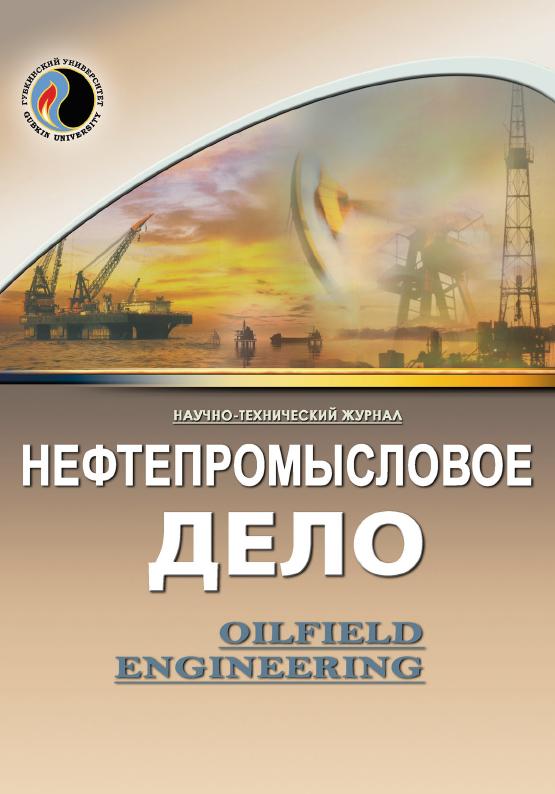Scientific and technical journal
«Oilfield engineering»
ISSN 0207-2351

A new solution to the old problem: description of the characteristic specific features of the viscous-elastic media rheological behavior
UDC: 622.276.1/.4.001
DOI: -
Authors:
1 St. Petersburg Mining University, St. Petersburg, Russia
Keywords: viscousity-elasticity, strain curve, shear, stress, deformation lag, stress relaxation, maximum stress
Annotation:
By now, a lot of mechanistic rheological models have been developed, representing various combinations of Hooke’s, Newton’s and Saint-Venant’s bodies. However, these models describe the behavior of various media only in particular cases, which, according to experts’ opinion, is caused by the complex rheological behavior of various materials. The reason for this trend may be the fallacy of the existing approach, and therefore another method for describing the rheological behavior of viscous-elastic media has been proposed. The fundamental difference from other models is the simultaneous consideration of the stress and shear mutual influence, when stress affects shear, which in turn affects stress, etc. It is achieved by connecting many Maxwell and Kelvin elements in time, while the unknown ones are only four parameters. This model describes the main features of rheological behavior: stress relaxation, deformation lag, the influence of loading rate or shear rate on the deformation curve, hysteresis of the curve and presence of a stress maximum when the shear rate changes, etc. The model was tested during studying polymer solutions, high-viscuos oil and plastics. It has been revealed that, under certain conditions, damped viscous-elastic oscillations may appear, which can explain the resonance phenomena occurrence in various bodies. Additionally, the possibility of using the well-known Burgers equation in the equations of motion to determine rheological parameters is shown.
Bibliography:
1. Rogachev M.K., Aleksandrov A.N. Obosnovanie kompleksnoy tekhnologii preduprezhdeniya obrazovaniya asfal’tosmoloparafinovykh otlozheniy pri dobyche vysokoparafinistoy nefti pogruzhnymi elektrotsentrobezhnymi nasosami iz mnogoplastovykh zalezhey // Zapiski Gornogo instituta. – 2021. – T. 250. – S. 596–605. – DOI: 10.31897/PMI.2021.4.13
2. Vyalov S.S. Reologicheskie osnovy mekhaniki gruntov: ucheb. posobie dlya stroit. vuzov – M.: Vyssh. shk., 1978. – 447 s.
3. Gorbunov A.T. Razrabotka anomal’nykh neftyanykh mestorozhdeniy. – M.: Nedra, 1981. – 237 s.
4. Dvoynikov M.V., Kuchin V.N., Mintsaev M.Sh. Razrabotka vyazkouprugikh sistem i tekhnologii izolyatsii vodonosnykh gorizontov s anomal’nymi plastovymi davleniyami pri burenii neftegazovykh skvazhin // Zapiski Gornogo instituta. – 2021. – T. 247. – S. 57–65. – DOI: 10.31897/PMI.2021.1.7
5. Diyashev R.N., Kosterin A.V., Skvortsov E.V. Fil’tratsiya zhidkosti v deformiruemykh neftyanykh plastakh. – Kazan’: Izd-vo Kazanskogo mat. obshchestva, 1999. – 238 s.
6. Dobrynin V.M. Deformatsii i izmeneniya fizicheskikh svoystv kollektorov nefti i gaza. – M.: Nedra, 1970. – 239 s.
7. Zheltov Yu.P. Deformatsiya gornykh porod. – M.: Nedra, 1966. – 198 s.
8. Zubchaninov V.G. Osnovy teorii uprugosti i plastichnosti. – M.: Vyssh. shk., 1990. – 368 s.
9. Iktisanov V.A. Izuchenie osobennostey relaksatsionnoy fil’tratsii zhidkosti. – Palmarium Academic Publishing, 2012. – 125 s.
10. Iktisanov V.A. Opredelenie fil’tratsionnykh parametrov plastov i reologicheskikh svoystv dispersnykh sistem pri razrabotke neftyanykh mestorozhdeniy. – M.: OAO "VNIIOENG", 2001. – 212 s.
11. P’ezometriya okrestnosti skvazhiny. Teoreticheskie osnovy / Yu.M. Molokovich, A.I. Markov, A.A. Davletshin, G.G. Kushtanova. – Kazan’: DAS, 2000. – 202 s.
12. Nikolaevskiy V.N. Geomekhanika i flyuidodinamika. – M.: Nedra, 1996. – 447 s.
13. Reologicheskie osnovy rascheta oborudovaniya proizvodstva zhirosoderzhashchikh pishchevykh produktov: ucheb. posobie / V.A. Aret, B.L. Nikolaev, G.P. Zabrovskiy, L.K. Nikolaev. – 2-e izd., pererab. i dop. – SPb.: SPbGUNiPT, 2006. – 435 s.
14. Ur’ev N.B. Vysokokontsentrirovannye dispersnye sistemy. – M.: Khimiya, 1980. – 320 s.
15. Experimental and modeling study of the viscoelastic-viscoplastic deformation behavior of amorphous polymers over a wide temperature range / Fan Liu, Jin Wang, Shuchang Long [et al.] // Mechanics of Materials. – 2022. – Vol. 167. – Article 104246. – DOI: 10.1016/j.mechmat.2022.104246
16. S-PAL: A stabilized finite element formulation for computing viscoplastic flows / P. Moschopoulos, S. Varchanis, A. Syrakos, Ya. Dimakopoulos // J. of Non-Newtonian Fluid Mechanics. – 2022. – Vol. 309. – Article 104883.
17. On the nonlinear viscoelastic behavior of rubber-like materials: constitutive description and identification / A. Tayeb, M. Arfaoui, A. Zine [et al.] // International J. of Mechanical Sciences. – 2017. – Vol. 130. – P. 437–447.
18. Vaiana N., Rosati L. Classification and unified phenomenological modeling of complex uniaxial rate-independent hysteretic responses // Mechanical Systems Signal Processing. – 2023. – Vol. 182. – Article 09539. – URL: https://doi.org/10.1016/j.ymssp.2022.109539
19. Predictive model for stress relaxation behavior of glassy polymers based on variable-order fractional calculus / G. Xiang, D. Yin, R. Meng, С. Cao // Polymers for Advanced Technologies. – 2020. – Vol. 32(1). – P. 703–713. – DOI:10.1002/pat.5123
20. A viscoelastic two-phase solver using a phase-field approach / K. Zografos, A.M. Afonso, R.J. Poole, M.S.N. Oliveira // J. of Non-Newtonian Fluid Mechanics. – 2020. – Vol. 284. – 104364.